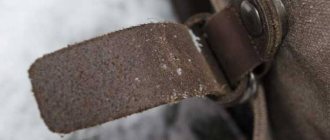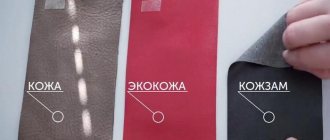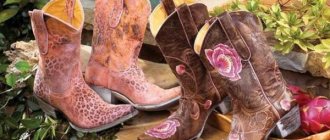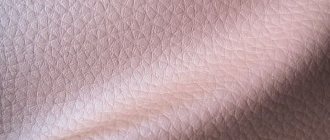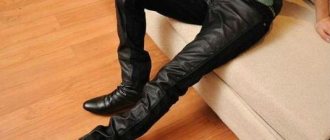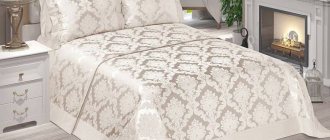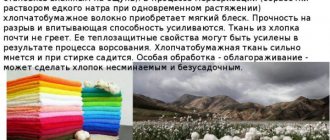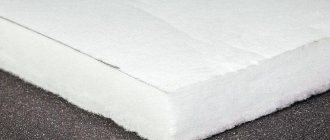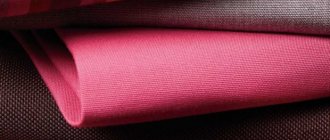For the health of the musculoskeletal system, the type of shoes we wear is very important. It needs to fit well, fit properly, and be made from high quality material to last long enough. Many consumers choose shoes made of genuine leather for daily wear, rejecting products made from artificial leather and eco-leather. What should you pay attention to when shopping in a shoe store in order to purchase a truly high-quality product that you won’t have to return after the first wear? What kind of leather do modern manufacturers make shoes from, and should the buyer overpay for naturalness?
High-quality shoes - what are they made of?
The assortment presented in retail outlets is simply dizzying. Ballet flats, sandals and sandals are replaced by moccasins and pumps, followed by windows filled with shoes and boots. The main selection criterion is the quality of the products that will have to be worn on your feet. What materials are shoes made from in factories?
A natural skin
Ideal for sewing shoes. It is strong, durable and practical. This is a soft, warm and comfortable material from which you can make a variety of models for all seasons. Its cost is quite high, but it pays off in the longevity of its operation.
What leather are shoes made from?
- calf - very soft and durable, suitable for embossing;
- pork - the cheapest, used for sewing products in the budget segment;
- cowhide - for the middle price segment, quite tough, but has a noble appearance;
- bull - not suitable for creating sophisticated things, but does not get wet and is inexpensive;
- crocodile - used for the manufacture of exclusive products, its price is high, and its appearance is luxurious;
- deer - used for sewing slippers, it is characterized by wear resistance and excellent heat-saving properties.
Leather products require careful care. This is an absolutely safe “breathable” material that does not cause allergies or irritation.
Faux leather
What else are shoes made from to minimize their cost? Made from artificial leather, the price of which is significantly lower than natural leather. It has some advantages:
- does not get wet longer in bad weather;
- maintains model shape;
- Easily painted in different colors.
However, faux leather boots will not withstand very low temperatures, and sandals or shoes that do not allow air to pass through will cause your feet to sweat a lot. The disadvantages also include the low durability of the products - they will last a maximum of 1 season.
Synthetic leather
Leatherette has long been popular among consumers. Shoes made of leatherette are cheap, but during active wear they quickly become deformed. At first glance, it is quite difficult to distinguish this material from leather, but when you touch its surface, you immediately feel the difference - there is no heat transfer. Leatherette can be recognized by its knitted or cotton inner base.
Combination skin
To reduce the cost of a pair of shoes, manufacturers use some tricks. Today, the demand for products made from combination leather has increased - durable and safe shoes, but what this is needs to be explained. The main characteristics of such shoes are environmental friendliness, practicality, and comfort for the feet. What is combination shoe leather? This is a combination of natural and artificial materials, their proper arrangement in the model depending on the purpose of a particular area. How are these shoes made? Natural material is used for parts that should be elastic, durable and breathable, and non-natural raw materials are used for the rest of the design.
How to determine the material of shoes if visually different models look almost the same? There are some tricks that will allow buyers to choose quality.
How is follicular hyperkeratosis treated?
It is unlikely that you will be able to prevent the appearance of goose bumps and get rid of them forever. Typically, this condition either goes away on its own or has to be controlled throughout life with the help of medicinal cosmetics, which alleviate unpleasant symptoms and temporarily improve the appearance of the skin.
Cosmetics* that can help get rid of keratosis:
- lotions or creams with 2-10% lactic acid (ammonium lactate);
- creams with urea;
- cream or gel with 0.1% tretinoin;
- cream or gel with 0.1% adapalene;
- cream or gel with 0.05% tazarotene.
* There are contraindications; before use, read the instructions and consult a specialist.
Natalya Kotova, dermatovenerologist:
Skin affected by follicular hyperkeratosis requires constant long-term care. You need to apply creams at least once a day - this will help eliminate flaking.
It is possible that vitamin A deficiency plays a certain role in the development of follicular hyperkeratosis. Therefore, along with the main treatment, patients are often prescribed vitamins A, group B, vitamins C and E, and exposure to ultraviolet radiation - in other words, they are advised to spend more time in the sun. It also makes sense to discuss your salt bath schedule with your dermatologist.
How to choose leather shoes
High-quality footwear is not cheap, so you don’t want to spend a lot of money on moccasins, boots or shoes that will become unusable after a short period of wear. How to determine whether shoes are leather or not? You need to know what is typical for natural materials.
- How to check whether shoes are leather or not right at the point of sale? You need to place your palm on the top surface of the product and wait until it warms up and begins to give off heat. If the products are made of leatherette, you will not feel any thermal changes.
- Take the product in your hands and touch the reverse side. For non-natural models it is made of fabric, while for those made of leather it is harsh, similar to suede.
- How are shoes made from artificial materials? Due to the fleecy nature of the fabric lining, leatherette products are sewn by folding the sections inward. Leather shoe pairs usually have untreated seams and open edges.
- Sometimes combination leather is passed off as genuine - what kind of well-tailored shoes should it be for the consumer to give it their choice? Manufacturers add non-functional small inserts to models made from cheap material or attach a leather tag, misleading the buyer.
- You can do a water test. One drop is enough, which, when it hits the surface, will harden and begin to be slowly absorbed, rather than spreading and flowing, to make sure that you have a leather pair in front of you.
When can dry skin be dangerous?
Excessive dry skin, accompanied by other symptoms, may indicate a serious illness. Here are some of them.
Diabetes. This disorder of carbohydrate metabolism affects many organs. One of the symptoms of diabetes is itchy skin and dry skin in the folds. Pustules and ulcers form on the skin. Other symptoms are thirst and frequent urination, weakness.
Hypothyroidism. With insufficient thyroid function, the skin begins to peel off and red spots appear on the neck and chest. Other manifestations of the disease include chilliness, puffiness, pallor, and cold hands and feet.
Psoriasis. This non-infectious skin disease is manifested by the appearance of plaques with dry and flaky skin with the formation of scales. Plaques can itch and hurt. The elbows, knees, head (hairy part), and lower back are most often affected.
Eczema. It manifests itself as dry skin, rashes and itching.
Allergy. The main signs of allergies are rash and redness. But along with them or after them, dry skin, itching, and swelling occur.
Ichthyosis. A genetically determined disease manifested by very dry and thickened skin with the formation of scales. Most often it affects the bends of the elbows, knees, ankle joint, and lower back.
Fungal skin lesions. As a rule, the fungus affects the feet, less often the palms. The first symptom is dry, itchy and flaky skin between the fingers.
Rules for conducting a visual inspection
How can you tell if a shoe is leather or not by looking at it? When performing a visual inspection, you must follow the advice of specialists.
- Look for a graphic tag, sticker or imprint with a genuine leather symbol.
- Check the pairing of shoes. The material must be uniform, the same color, the trim and cut should be symmetrical, the height and elasticity of the backdrop should be identical.
- The decorative bezel can lag behind the side surface by a maximum of 1 mm.
- Heels must be the same height - the maximum permissible difference is up to 2 mm. Good quality is indicated by the absence of cracks and distortions.
- How to identify leather shoes by eye? Pay attention to the sole. Its thickness should be uniform, and the parts should fit tightly to the bottom and stitched with stitches without gaps.
Good leather shoes cannot be cheap. A price that is too low should alert the buyer - perhaps this is an excellent fake. Buy products only in specialized stores with an impeccable reputation, where the quality of the product is confirmed by specialists.
You may be interested in: How to care for suede shoes How to remove unpleasant odor from shoes Water softening: quickly removing harmful impurities
Natural leathers vary in:
- grinding method
- coloring method
SMOOTH SKIN WITH LIGHT PIGMENTATION
This type of leather is made from hides that have a certain number of natural defects that are sanded. Next, a pattern is applied using embossing, replenishing the lost natural pattern, to create a uniform surface (half-face). The surface of the leather is covered with a thin layer of topcoat.
Features: the hair follicles are half filled with dyes, which increases the scratch resistance of the shoe surface. It also allows us to produce shoes in a wide range of colors.
PIGMENTED SMOOTH SKIN
Before dyeing, this type of leather is first completely sanded, and then the surface is covered with several layers of opaque topcoat.
Features: This leather is resistant to surface scratches. It also allows us to produce shoes in a wide range of colors. It does not require maintenance and is durable.
EMBOSSED LEATHER
Any smooth leather can be embossed. A pattern of any design is applied to the surface of the leather (for example, crocodile, snake, etc.) using special rollers under high pressure and high temperatures. After which the leather is covered with a layer of topcoat and protective varnish.
Features: in this way the shades and texture of reptile skin are most realistically conveyed. These leathers are dirt resistant and water repellent. This leather is used in shoes to highlight the elements of the boot, making it more stylish, fashionable and current.
SUEDE
Suede is genuine leather that does not have a “natural face”, coated with aniline dye and polished with abrasives to give a fleecy appearance. Suede is made by one of two methods: first, during tanning, the leather passes through a cutting machine, where long, very sharp knives separate the leather into two layers, the first layer is used to make smooth leather, and the second is used to make suede; the second method consists of turning the skin inside out and sanding its inside. This type of suede is called "back suede" because the grain layer remains on the inside of the shoe.
Features: suede shoes have a very expensive and noble look. Suede is a very porous material that allows shoes to “breathe”; it allows and absorbs water well. Requires constant careful care.
NUBUCK
Nubuck is made from carefully selected soft and supple full-grain leathers treated with aniline dye. Thanks to the grained surface and polishing of the grain of the leather, nubuck obtains the famous fine velvet pile.
Features: shoes made of nubuck are characterized by an attractive appearance. However, nubuck requires more careful care with special products to preserve the appearance of the shoe.
OILED NUBUCK
At the first stage of production, the leather is subjected to the same processing as in the production of regular nubuck. However, the material is then passed through a heated cylinder, with the help of which a mixture of oils and wax is applied to the skin. The raw material is then dried for 24 hours to avoid depositing fat on the surface of the skin.
